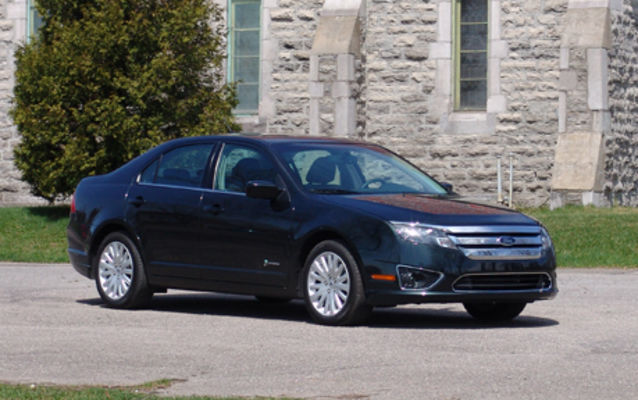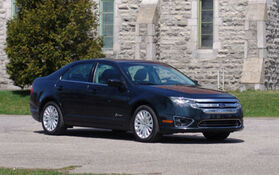Gain Momentum with the 2010 Ford Fusion
Times are tough for two thirds of American car manufacturers. The other third, Ford, seems to be coping much better. Over the last few years, product quality at the “Blue Oval” has significantly improved, though it has yet to be perfected. Ford’s reliability has also made some big strides, as well as its design, which is always a fundamental selling point. Recently unveiled to the Quebec press, the 2010 Ford Fusion has entered the market and is capitalizing on this momentum.
Ford hasn’t strayed a lot from the previous model of the Fusion, though they’ve made enough changes with the 2010 to make it stand out, all while ensuring that it stays in style aesthetically. The front end has been redesigned and now features a three-bar chrome grille with the Ford emblem at the center. At the back, the lights have been redesigned and the brake lights repositioned. With this restyling, engineers were able to improve the vehicle’s soundproofing: the windshield isolates better from exterior noises, the carpets are thicker and soundproofing material has been added to pillars A and B.
Five models, four engines
With the 2010 Ford Fusion, there are five flavours to choose from: the S, SE, SEL, Sport and Hybrid. The base models are equipped with 2.5-litre 4-cylinder units that deliver an output of 175 hp and are the very same engines found in the Ford Escape. With the SEL model, you get the option of upgrading to the timeless 3.0-litre V6 producing 240 hp. The sport edition is a little more intense, with a 3.5-litre V6 that delivers an output of 263 hp; this engine is also found in the Escape. The Hybrid, of course, works a little different from the rest, and we’ll touch on it in more detail later.
We feel that the Sport edition of the Fusion is the most well-thought-out, mainly because you get the option of equipping the 3.5-litre V6 with AWD. You also get the AWD option with the SEL 3.0-litre V6. With the exception of the Hybrid, all of the Fusion models are equipped with a 6-speed automatic transmission, although you can opt for the manual box for the more economical models. Currently, a 6-speed manual transmission is the standard offer.
Inspired more than you might think by the Mazda6 , the Fusion’s handling is not particularly sporty but certainly meets today’s standards. We had the opportunity to test drive the 4-cylinder FWD automatic, which will undoubtedly be the most popular model. It doesn’t offer the best accelerations, but it could be worse. Thanks to the efficient soundproofing, you can’t feel the 2.5-litre engine at work, and the quick and timely gear shifts only add to the pleasant driving experience. However, it is worth noting that during our test drive, we did notice that shifting in lower gears was sometimes a bit jerky. In regards to the manual gearbox , which is never a particularly popular option, especially with this class of vehicle, we have no complaints about it. The gear changing is precise, there isn’t much distance between the gears, and the clutch doesn’t seem too soft.
We were also able to test drive the 3.5-litre AWD Sport edition. Even though this model is a higher-performance vehicle than the 4-cylinder, don’t go thinking that it’s is a real sports car. On a deserted stretch of road, it did 0-100 in 7.4 seconds (timed by hand). The acceleration is strong and in full acceleration, the torque steer is cancelled out by the AWD. However, the AWD Sport edition weighs in at 1650 kg, compared to 1516 kg for the FWD version, and naturally that means greater fuel consumption: approximately one extra litre per 100km (about 12.6 litres/100km in the city and 8.3 litres on the highway for the AWD, according to Ford; we don’t have the numbers on FWD).
Thanks to my impeccable physique (as well as the tilt steering column!), I was able to find a comfortable driving position. The steering wheel itself is not something to write home about, but we’ve certainly seen worse with Ford, and we actually found the steering to be quite accurate. Notice that I didn’t use the term “surgical precision,” which would have been a little over the top! The brakes certainly do the job; the Sport edition that we test drove had a leg up on all the other models available that day because it had Goodyear Eagle RS-A tires. We all know that better tires equal better braking distances. The rear multi-link independent suspension in back and short- and long-arm independent suspension up front does a very good job of keeping passengers comfortable. However, we did notice there was a certain degree of body on tight turns and that it had a tendency to under-steer, but this isn’t really a big deal as long as you have the common sense to slow down.
A more refined interior
The interior soundproofing is something that really jumps out at you – after only a few kilometers, you realize that the efforts of the engineers have not been in vain. For some time now, Ford has been paying particular attention to this area. Almost all of the models offer an optional GPS system, which is great. But I feel that spending $2100 (not including taxes) on an option that most people will only use occasionally is simply too much. On top of this, I really like the look of the dashboard without the GPS, as there are fewer buttons and it doesn’t seem as cluttered. The Sport edition dashboards feature blue, red or slate gray colour themes which go well with the leather seats. So even where it does less well, it does well. The seats are comfortable, at least for the short amount of time that we were test-driving the cars. It’s worth noting that this year the seats are firmer than in previous models and, according to Ford, provide better support. As far as trunk space goes, there’s plenty of it.
The Hybrid
As recently as last week, an American Ford Fusion Hybrid traveled 1445 miles (2325km) on only one tank of gas, which works out to an average of 2.9 litres/100km. Wow. During the unveiling of the Fusion to the Quebec press, a challenge was put forth by Ford: which team of journalists could get the lowest average. They had the journalists drive through the streets of Old Quebec and its surroundings. Thanks to my colleague Nadine, we managed to post an average of 5.3 litres/100km, which is pretty good considering that, being the terrible polluter that I am, I wasn’t even able to crack an average of 6.9 litres/100km. The winning team had an average of 5.2, if my memory serves me correctly (less than 526 k at the time). That’s all fine and dandy, but to get an average like that you’re going to have to be ruthless and drive like there’s no tomorrow!
It CAN do the job, but will it?
Technologically, Ford seems to have done a good job considering the current constraints in hybridization. First off, let’s clarify that we’re talking about a hybrid system which is very similar to the one found in the Ford Escape, except it’s much more up-to-date. The nickel-metal hydride batteries (275 volts) are smaller than in previous models, and lighter too. According to Ford, they’ll also last just as long as the other ones (several years), which leaves them a rather large margin of error! The Hybrid’s gas engine is a 2.5-litre Atkinson-cycle engine, while the 70kW electric engine can keep the car running as long as the demand for energy isn’t too great. It’s even possible to reach 75km/h, but we strongly advise against trying this on the QEW. The gas and electric engines combine for 191 hp and 136 ft-lb of torque and both have eCVT transmission. A system called VSC (Vehicle System Controller) runs everything.
The Fusion Hybrid is certainly efficient, and the transition between gas and electric is clear. But don’t get fooled by the gas consumption numbers, which have been obtained in certain specific circumstances. For day-to-day driving, the Hybrid will definitely consume less than the average 4-cylinder engine, but it is up to you to figure out whether or not the difference is substantial enough to offset expenses such as the initial purchase, maintenance and resale. Also, there’s a good chance that not all dealerships will be able to do maintenance on it. On top of that, you have to live with seat backs that don’t recline and a trunk that is 133 litres smaller in volume (compared to the standard 467-litre trunk).
Smart Gauges
We could also spend a long time talking about the Hybrid dashboard alone. This environmentally friendly Hybrid uses a technology called Smart Gauges, which involves HD video instrumentation. Four display options are offered but it’s a safe bet that users will simply use the one they like best and forget about the rest. Even though these Smart Gauges appear quite user-friendly, it seems they take some getting used to (at least for me anyways!) before you can easily find your way through all the menus (these menus are accessed by various buttons on the steering wheel).
For the 2010 Fusion, prices vary from $21,499 for the S, all the way to $35,299 for the Sport edition. Between the two extremes, you’ve got the SEL 4-cylinder for $25,799, the SEL V6 for $28,799, the SEL V6 AWD for $30,799 and the Hybrid for $31,999.
The 2010 Ford Fusion is a testament to the progress Ford has made. It is well designed mechanically and generally reliable. It’s a pleasure to drive and the interior is more refined than in previous models. As far as the Hybrid goes, it has its merits, but I still don’t think that it’s worth the money, despite its many accolades and all the advertising hype surrounding it. But certainly from a marketing standpoint, this approach is making money and is indirectly giving exposure to the other Fusion models, which are less technologically developed but much more realistic.












